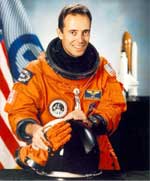
Jean-Francois Clervoy
STS-103 Mission Specialist No. 2
NASA BIOGRAPHY
Posted: Dec. 14, 1999
| |

Photo: NASA
|
Personal Data:
Born November 19, 1958, in Longeville-les-Metz, France, but considers Toulouse, France, to be his hometown. Married to the former Laurence Boulanger. They have two children. He enjoys racquet sports, skill games, canyoning, skiing, and flying activities such as boomerang, frisbee, kites. His father, Jean Clervoy (French Air Force, Ret.), and his mother, Mireille Clervoy, reside in Franconville, France. Her parents, Robert and Juliette Boulanger, reside in Le Perreux-sur-Marne, France.
Education:
Received his baccalaureat from College Militaire de Saint Cyr l' Ecole in 1976; passed Math. Sup. and Math. Spe. M' at Prytanee Militaire, La Fleche in 1978. Graduated from Ecole Polytechnique, Paris, in 1981; graduated from Ecole Nationale Superieure de l' Aeronautique et de l' Espace, Toulouse, in 1983; graduated as a Flight Test Engineer from Ecole du Personnel Navigant d' Essais et de Reception, Istres, in 1987.
Organzations:
Member, Association of Space Explorers. Honorary member of the French Aeronautics and Astronautics Association.
Special Honors:
NASA Space Flight Medal. Chevalier de l' Ordre National du Merite. Chevalier de l' Ordre National de la Legion d' Honneur. Komarov Award. NASA Exceptional Service Medal.
Experience:
Clervoy was seconded from the Delegation Generale pour L' Armement (DGA) to CNES (French Space Agency) in 1983, where he worked on automatics and attitude control systems for several satellite projects. He was selected in the second group of French astronauts in 1985 and subsequently undertook intensive Russian language training. After graduating as a flight test engineer in 1987, he spent the next five years part-time at the Flight Test Center, Bretigny-sur-Orge, as Chief Test Director of the Parabolic Flight Program, responsible for testing and qualifying the Caravelle aircraft for microgravity, and part-time at the Hermes Crew Office, Toulouse, where he supported the European Manned Space Programs in the fields of extravehicular activity, rendezvous and docking, robotic arm, and man machine interface. In 1991, he trained in Star City, Moscow, on the Soyuz and Mir systems. In 1992, he was selected to join the astronaut corps of the European Space Agency (ESA). He holds military and civilian parachuting licenses, military and civilian diving licenses, and private pilot license. From 1983 to 1987, Clervoy was also a lecturer in signal processing and general mechanics at the Ecole Nationale Superieure de l' Aeronautique et de l' Espace, Toulouse. Jean-Francois holds a commission as Ingenieur en Chef de l' Armement in the DGA.
NASA Experience:
Clervoy reported to the Johnson Space Center in August 1992. Following one year of training he qualified as a mission specialist for Space Shuttle flights. Clervoy was initially assigned to the Astronaut Office Mission Development Branch where he designed a new concept of robotic steering displays. After his first space mission he was assigned as flight software verification lead in the Shuttle Avionics Integration Laboratory (SAIL) and was responsible for designing the International Space Station (ISS) robotics displays for the Astronaut Office Mission Support Branch. Following his second space mission, he was assigned as ISS displays integration lead for the Astronaut Office Computer Support Branch. He flew twice aboard Space Shuttle Atlantis and has logged over 483 hours in space. He served as a mission specialist on STS-66 in 1994, and was the Payload Commander on STS-84 in 1997. Clervoy is assigned to STS-103, the third Hubble Space Telescope Servicing Mission.
Spaceflight Experience:
STS-66 (November 3-14, 1994), the Atmospheric Laboratory for Applications and Science-3 (ATLAS-3) mission was part of an ongoing program to determine the Earth's energy balance and atmospheric change over an eleven-year solar cycle. Clervoy used the robotic arm to deploy the CRISTA-SPAS atmospheric research satellite 20 hours after lift-off, and logged 262 hours and 34 minutes in space and 175 orbits of the Earth. STS-84 (May 15-24, 1997), was NASA's sixth Shuttle mission to rendezvous and dock with the Russian Space Station Mir, during which he logged 221 hours and 20 minutes in space and 144 orbits of the Earth.

|
 |
 |
 |
Explore the Net
NASA Human Spaceflight - Space agency Web site dedicated to International Space Station and space shuttle programs.

Press kit - Official STS-103 mission press kit.

Shuttle Media Reference Guide - Complete in-depth look at space shuttle systems and facilities.

Shuttle Countdown Online - NASA Kennedy Space Center site with pre-launch information.

Hubble Space Telescope - Home page of NASA's first Great Observatory.

HST Servicing Mission 3A - NASA site focused on this servicing mission of Hubble.

European Space Agency - partner in HST program and has two astronauts flying on STS-103.

United Space Alliance - prime contractor responsible for daily shuttle processing work.

Thiokol - Manufactures the shuttle's solid rocket boosters.

Rocketdyne - Division of Boeing that builds shuttle main engines.

Lockheed Martin - Corporation that builds the external fuel tank.


NewsAlert
Sign up for Astronomy Now's NewsAlert service and have the latest news in astronomy and space e-mailed directly to your desktop (free of charge).


|

